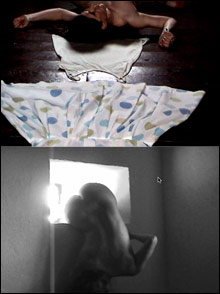
MARJORIE MORGAN: Wriggling out of a dress in "Slough" (top), inching up over a windowsill in "Ascent" (bottom). |
Lost on the way to "11+1" — a "Sidewalk Tzara" event comprising 11 avant-garde films and one live performance a week ago Thursday — and floundering through the inner canyons of MIT, I stopped to ask directions from a passer-by. A few minutes later, I parked my car (illegally) in Inman Square and followed the handmade signs to Outpost 186. I was talking to friends in the entrance way when my rescuer walked in. He'd been headed for the same place.The hour's worth of film and dance that followed my absurdist journey offered flashbacks, edges, mysterious messages, and a thunderstorm. In 1924, Tristan Tzara described Dada as a resistance to the pretensions of art, "a snow of butterflies released from the head of a prestidigitator." I left Inman Square feeling energized.
The program featured George Manupelli, the avant-garde filmmaker who started the Ann Arbor Film Festival in the 1960s. A Boston native, Manupelli now lives in New Hampshire, and he still makes films. This diffident, rumpled geezer and icon talked briefly about his work to the 30 or so viewers, half of whom probably hadn't heard of his collaborators, composers Robert Ashley and Gordon Mumma. His "5 Short Films" was about — or not about — "spurned love," he said.
Screened on a cranky old 16mm projector, "5 Short Films" hadn't been seen in public for 25 years. It was made in the mid '60s, when avant-garde movies looked and sounded homemade, even if they weren't meant to. Each of Manupelli's five pieces began with a dramatic title ("Say nothing about this to anyone"; "I must see you"). The screen went black, with faint blotches. You heard someone trying to start a car with a dead battery. Blinding lights went on and off. To the sound of an early synthesizer, the film seemed to have become stuck in the projector and burned. My eyes begin to see after-images when I blinked.
Dancers Katherine Ferrier and Jen Green — the "1" in "11+1" — wafted in front of the screen, letting the image imprint itself on their bodies. Fractured and disembodied bodies played a part in all the other films, as well.
With her own vocalizations as background, Marjorie Morgan played with the camera's ability to tease, deceive, reveal. For "Hand Dance," two hands moved close to the lens, creating slippery shapes and designs. In "Slough," the camera drew back from a swath of polka-dotted fabric to show Morgan's foreshortened body slowly wriggling out of a dress. Then she sloughed off a white satin slip, like an insect shedding its skin, and began rolling out of the frame. In "Ascent," sensuous curves and a square of light turned out to be another naked body, this one inching its way up over a windowsill. At the end, it was arrested half in and half out of the window. Or maybe Morgan had been stealthily climbing in, and the film was running in reverse.
Dancer/choreographer Marie Chabert, dressed in gauze, whirled and skipped on a woodsy lawn for Will Donovan's camera in the three-minute "Day of the Pixie." Chabert might have taken flight, but the camera confined her, ecstatically going in and out of focus, sidling up close to her body, but never letting her escape its eye.